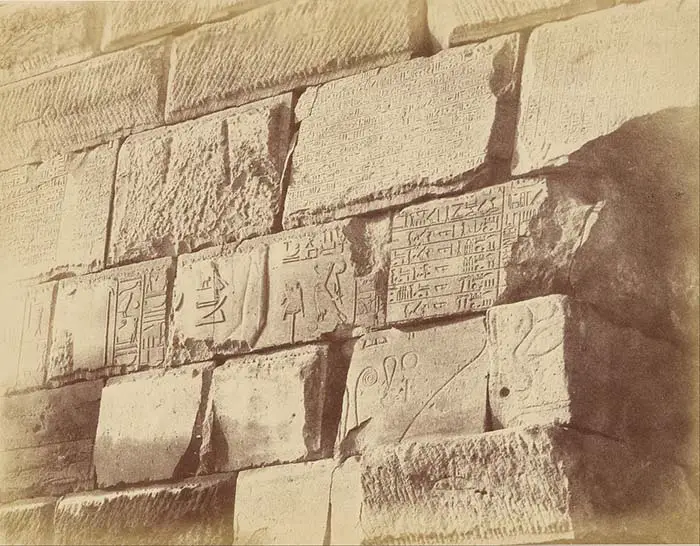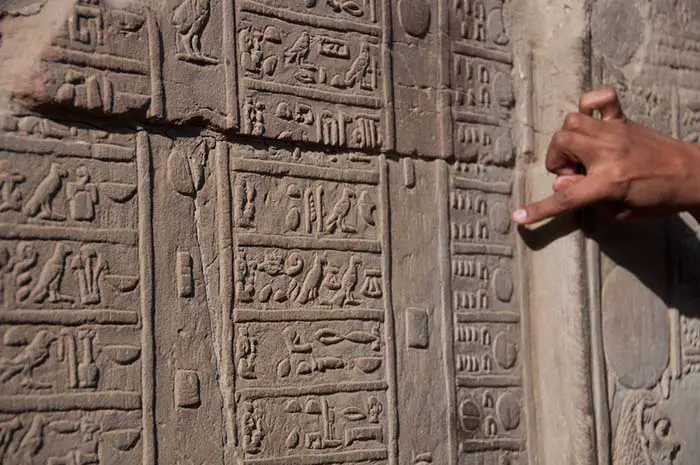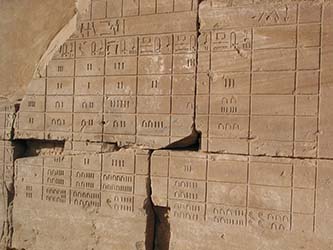The Ancient Egyptian Calendar
The exact origin of the ancient Egyptian calendar is unknown, but it is estimated to have started around 5,000 years ago. The ancient Egyptians used a lunar calendar exclusively until they adopted their solar calendar.
The lunar calendar was then used for their religious festivals and rituals, but for their daily lives, the ancient Egyptians used a solar calendar which contained 365 days per year. Each year was comprised of three, four-month seasons, which were named after significant events related to their agrarian lifestyle.
Times of the Egyptian Calendar
The Egyptian calendar was broken down as follows:
- One week was ten days.
- Three weeks was one month.
- Four months was one season.
- Three seasons and five holy days was one year.

Depiction of an Egyptian hieroglyphic calendar
The first season - was called Akhet, which means flood or inundation. It included the months of Tekh, Menhet, Hwt-Hrw, and Ka-Hr-Ka.
The second season - was called Proyet, which means emergence. Its months were Sf-Bdt, Redh Wer, Redh Neds, and Renwet.
The third season - was called Shomu, which means low water. The names of its months were Hnsw, Hnt-Htj, Ipt-Hmt, and Wep-Renpet.
Each month consisted of three ten-day periods called decades or decans. Although the months were individually named, they were commonly referred to by the name of the festivals they represented. The last two days of each decade were considered holidays and the Egyptians didn't work.
A month was 30 days long on the Egyptian solar calendar. Since this didn't account for all the days in the year, the Egyptians added an intercalary month that occurred outside of the regular calendar year.
The intercalary month was five days long, which meant that the Egyptian solar calendar lost about one-fourth of a day every year relative to the actual solar year. The five intercalary days were used to celebrate the gods' birthdays and the Egyptians weren't expected to work during this time.

© Robert Young - Calendar at Kom Ombo
Decans are groups of stars in ancient Egyptian astronomy that were used to tell time at night. The rising of each group indicated a new sidereal day. There were 36 groups, or decans, of stars. Each decan consisted of ten days, which yielded a 360-day year.
Names of the decans are known but their locations and their relationship to modern constellations are unknown. A sidereal day is defined as the time taken for one rotation of the earth relative to the stars. It's approximately four minutes shorter than a solar day.
The Canopus Decree, issued by Ptolemy III, provided for a sixth epagomenal day every fourth year in order to correct this discrepancy. However, the priests and the population in general resisted this change and it was eventually abandoned until Augustus established the Coptic calendar in 25 BC.

© globetrotter_rodrigo - Egyptian Calendar
Dates for common people were written with the number of the month in the season first. Next would be the name of the season, then the number of the day relative to the month, and then the year and the ruler. The ascension of a new ruler restarted the year count.
Occasionally, the year count began with the first full year of the new ruler but would include the time before that with a note to differentiate between the two time periods.
It was important to maintain accuracy between the solar calendar year and the actual solar year so that the heliacal rising of Sirius would occur properly. The heliacal rising would occur when Sirius was briefly visible on the horizon immediately before sunrise.
Sirius was vitally important to the Egyptians because it was the basis of their religion.
Before the introduction of astrology, ancient Egyptians used the solar calendar exclusively, marking their days and years by stellar events. The heliacal rising of Sirius for example, was the start of the Nile flooding, which occurred every year at Cairo. After the introduction of astrology, the rise of the decans and the stellar occurrences indicated the onset of diseases and the timing for their cures.

Sirius (bottom) as viewed from the Hubble telescope
Importance of Sirius
In addition to being the brightest star in the sky, Sirius was important to the ancient Egyptians for other reasons. It was considered to be the power behind the sun. The sun kept the physical body alive and Sirius kept the spiritual body alive.
Sirius was associated with Isis, the mother goddess of the earth, who is part of the trinity of Egyptian mythology. The Great Pyramid of Giza is said to be built in alignment with Sirius.
Facts About the Egyptian Solar Calendar
- The old Egyptian calendar was used into the middle ages because its days and months remained consistent. This facilitated their calculations.
- A day for the Egyptians started at sunrise, while many surrounding cultures started their day at sunset.
- Egyptians initially used sundials, hourglasses, and obelisks to tell time during the day and the stars to tell time at night. The introduction of water clocks enabled them to tell time more accurately.
- A civil lunar year, not tied to Sirius, was added every four years to account for the extra day needed to balance the solar calendar to the Egyptian calendar. This was known as the wandering year, or annus vagus.
- July 19th was the Egyptian new year. That was the date that Sirius reappeared on the eastern horizon after a 70-day absence, and the date the Nile began to flood.
- Some historians believe that Sirius was the star that the wise men followed en route to the birthplace of the baby Jesus.
